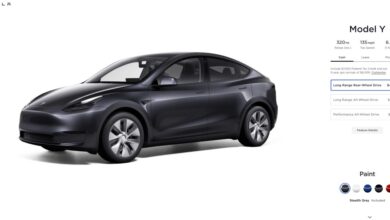Give Us the Dumbphone EV

If you haven’t heard, the dumbphone is back. Vexed by their emotionally ruinous smartphone addiction, plenty of people, including those of the tech-savvy younger generations, are turning their backs on iPhones and Androids to embrace internet-free cellphones that walked right out of the 1990s.
The impossibility of TikTok is not the dumbphone’s only winning feature. Flagship smartphones are expensive and delicate. Despite Apple’s soft cooing about the iPhone’s beautiful facade, you must shield that design behind a plastic case at all times, lest you drop your $1,200 investment and ruin it. Dumbphones, though, are rugged and cheap. They do their job without fuss or pretense. They are an appliance, and they know it.
This attitude needs to come to electric cars.
Ever since the rise of Tesla, it’s become a popular cliche to say electric vehicles are just smartphones on wheels, closer in spirit to the devices of Silicon Valley than to the combustion cars of Detroit. The comparison is apt. In addition to running on a large lithium-ion battery, today’s EVs are typically controlled through massive touchscreens. They are reliant upon software that receives over-the-air updates to fix its bugs and upgrade its features, just like your phone.
Like your mobile device, today’s EVs tend to present themselves as closed boxes not to be tinkered with. Some people go to the trouble of fixing a cracked screen or a withered battery to keep their smartphone running longer. For the most part, though, the tech giants have convinced people over the past two decades that phones should be replaced, not repaired, once they start to show their age.
Positioning EVs as fancy gadgets was a natural strategy to get Americans to lust after them, and to differentiate them from the gas-powered vehicles that came from an analog age. And it’s not hard to see why electric car makers would be keen to copy the “replace-don’t-repair” dynamic that arose around phones (to say nothing of the subscription creep that will ask you to pay extra monthly fees for car features).
But there’s no rule that says it must be this way. Electric cars don’t have to be defined by smartphone aesthetics and touchscreens and proprietary software; they don’t have to present as impenetrable to the garage mechanic. There is a better world where they are not only less expensive but also purposefully modular and obviously repairable, where parts, including the battery, could be swapped in to keep the car on the road as long as possible. They could feel rugged, like an old Buick LeSabre that just runs forever, rather than fragile and disposable.
I’m not just harping on this because America needs a simpler, more affordable EV to help the transition to electric. It’s also a sustainability issue. Gas-powered cars have grown more reliable and long-lasting over the years, and their increasing longevity means the average auto could be expected to reach 12 years and 200,000 miles, with lots of fluids, belts, brake pads, spark plugs, and cracked gaskets replaced along the way. They just keep on chugging, and emitting.
Electric cars are mechanically simpler. So it’s possible that, if their major components could be easily replaced, the vehicles themselves could last even longer, like an electric car of Theseus. It’s been done, even with today’s EVs. A 10-year-old Tesla Model S in Europe reportedly just surpassed 2 million kilometers, or about 1.24 million miles on the odometer. The EV has been through four battery packs and 14 motors to reach that wild total.
Few EV owners will go this hard to keep their vehicle on the road, but plenty of them will be presented with a simpler choice. The battery warranty of a current EV typically expires at 100,000 miles, and guarantees only that the pack won’t suffer more than 30 percent degradation during that time. Afterward, you’re on your own. So when a battery goes kaput at 150,000 miles, or has lost half its original range, EV drivers will face the classic car conundrum: whether to sink more money into an old car or buy a new one.
If the cost of batteries and motors really does fall in the near future once EVs go mainstream and technology advances, then more people will choose the former. What would make that choice even easier, however, is the feeling that your vehicle was really built for the long haul — that, unlike your phone, it isn’t simply one software update it can’t handle from becoming obsolete.
The alternative vision of EVs is out there. When I was first covering the Maker Faire hacker festival a dozen years ago, there were already guys out there who’d teach you how to hack a first-generation Mazda into a dead-simple electric car. (In the garage at Caltech, where I work, there’s someone who’s clearly done the same to a 1980s Porsche.) Like replacing 14 motors in an old Tesla, this is much more than the ordinary car owner wants to undertake. But it shows what is possible.
Tesla is apparently back in the race to make an affordable American EV, though it’s impossible to ever imagine the little Tesla being a dumbphone on wheels. Others, like Ford, are still trying. Perhaps with its EVs to come, the big Detroit brand can channel the spirit of the Ford Escort I drove in college: a plucky underdog that keeps on running, no matter how many people back into you in that icy parking lot.



